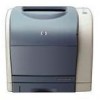HP 2500 HP Jetdirect Print Servers - Administrator Guide - Page 260
Certificates, Jetdirect Certificate, Encryption, Static WEP., dynamic encryption protocols.
 |
View all HP 2500 manuals
Add to My Manuals
Save this manual to your list of manuals |
Page 260 highlights
Certificates Digital certificates are used to validate the identity of network clients and servers and allow encrypted communications. A digital certificate is an electronic message typically containing, among other things, a key (a short string used for encryption and decryption) and a digital signature. Certificates may be issued and signed by a trusted third party (commonly called a Certificate Authority, or CA), which may exist internal or external to the organization. Or certificates may be "self-signed", which is similar to validating your own identity. To support EAP/PSK and selected EAP/802.1x authentication methods, an HP Jetdirect print server may need to contain one or both of the following certificates: G CA Certificate. A certificate from a trusted Certificate Authority (CA) is used to validate certificate information received from an authentication server. The CA must be the same as that used for the authentication server. G Jetdirect Certificate. A certificate that validates the Jetdirect device to the authentication server must be installed. The Jetdirect certificate may be issued by a trusted Certificate Authority, or may be self-signed, depending on the requirements established by the administrator of the authentication server. Encryption HP Jetdirect 802.11b wireless print servers support both static and dynamic encryption protocols. Static WEP. The IEEE 802.11b standard includes a WEP (Wired Equivalent Privacy) protocol for security. Using a secret key, a WEP algorithm provides data encryption immediately before wireless transmissions, and data decryption when received. While absolute security cannot be guaranteed, WEP security is considered the first significant line of defense against casual eavesdroppers. For WEP security, the WEP protocols must be implemented on each wireless device on your network. HP Jetdirect wireless print servers support WEP protocols. WEP security uses a secret key for authentication or data encryption on both the sending and receiving device. If a secret WEP key (analogous to a password value) is used for authentication, it ENWW HP Jetdirect 802.11b Wireless Print Servers 260















